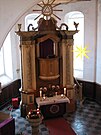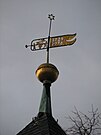Polenz Church
The Church of Polenz is a Protestant church building of the Evangelical Lutheran Church of Saxony in Polenz , a district of Brandis near Leipzig in the Leipzig district . In 1970 the church tower was shortened by about half, with a connection with the nearby Waldpolenz military airfield is likely.
history
In the anteroom of the church there is a large Romanesque font made of Rochlitz porphyry with a round arch frieze . It is proof that there was a church in Polenz as early as the 12th century. Apart from the construction costs of 2,400 thalers, no information has survived about a successor building at the same location around 1440.
The Reformation was introduced in Polenz as early as 1523: The manor owner Wilhelm von Lindenau brought Johannes Kress to the place as the first Protestant pastor. Kress had previously married a runaway nun.
On June 22nd, 1722, the foundation stone for today's existing church building was laid; the construction work was successfully completed in 1725. The church tower was 36 meters high at the time and a landmark in the flat Leipziger Land. From the tower, Pastor Gottlob Leberecht Schulze from Poland followed the fighting during the Battle of Leipzig in October 1813 with a telescope and later published his observations. Schulze worked in Polenz from 1809 to 1823, published school books and drafted the first Saxon elementary school law.
In the 19th century the interior of the church was redesigned several times, the most extensive in 1878 according to plans by the builder Altendorff from Leipzig at a cost of 8,030 marks. The pulpit was on the north side, the number of windows in the chancel was reduced from seven to four and were given stained glass, the triumphal arch was drawn in and the interior of the church was colored.
In 1970 the supposedly badly damaged tower hood with lantern was removed. Reasons for this were, in addition to a lack of construction capacity, the efforts of the GDR authorities to prevent the Red Army of the USSR from looking into the nearby Waldpolenz military airfield - as a result, the church tower lost its stately appearance to this day. In the 1970s, the roof and exterior plaster could be renewed with a lot of personal effort. The tower stump was raised by 5 meters and provided with a tent roof.
The interior of the church was renovated in 1828, 1878, 1893 and in the 1980s. At that time the pulpit altar came from the Church of Pulgar , which had to give way to open- cast brown coal mining . There is a heated winter church under the organ gallery . After the church tower and belfry had been renovated , the roof was re-covered in 2011.
The weather vane bears the dates 1725 (church consecration) and 1978 (completion of the exterior renovation). In addition, Joshua and Caleb can be seen carrying a large bunch of calves . The background for this is the Old Testament description of how the people of Israel set out for the promised land after their desert wandering and look to a good future.
Parish
The Church of Polenz and the City Church of Brandis have formed a parish since 1978; likewise the Beucha mountain church and the Albrechtshain church . The pastor of both parishes is Christoph Steinert from Brandis.
organ
The organ had a predecessor, as repair documents from 1783 and 1801 show. However, nothing more is known.
Today's organ was created in 1878 by the master organ builder Conrad Geißler (1825–1897) from Eilenburg - it has 13 registers , two manuals and a pedal . Thanks to extensive citizen engagement, the organ was preserved and restored in 2016 by the organ building company Peiter.
The main work contains the principal registers typical of the organ sound in different pitches and a drone that sounds an octave lower. In addition, there is the powerful double flute with two labia on each pipe and a so-called strings. The second manual also has a flute and a string part in the normal register and sounds like an echo to the first manual. The two pedal registers with principal bass in normal position and sub-bass an octave lower form the sound foundation of the organ.
The organ case with its flat, crenellated facade and the wide pointed arches of the five pipe fields refers to the English Tudor style , which was often used in representative buildings in the 19th century.
In order to arouse public attention for this Geissler organ, the organ was named "Saxon Organ of the Month" in June 2018 and performed at a concert in the series of events of the same name on June 23, 2018 with Markus Leidenberger, Regional Church Music Director of the Evangelical Lutheran Regional Church of Saxony .
According to information from the organ database ORKASA , the organ has the following disposition in 2018 :
|
|
|
||||||||||||||||||||||||||||||||||||||||||||||||
Bells
The current bells consists of two bronze - bells : they were in the 13th century (note c ", bottom diameter 680 mm, 275 kg) and in 1480 (sound f ', bottom diameter 1030 mm 675 kg) cast.
photos
literature
- Ev.-Luth. Parishes of Brandis-Polenz and Beucha-Albrechtshain (editor): The churches of Brandis, Polenz, Beucha, Albrechtshain. 22 pages with color illustrations, format 21 cm × 10 cm, 1st edition (4,000 copies), Brandis 2018, without ISBN
- Polenz, Nieder- and Ober-Polenz . In: August Schumann : Complete State, Post and Newspaper Lexicon of Saxony. 8th volume. Schumann, Zwickau 1821, pp. 482-485.
- The Parochie Polenz with the Ammelshain branch. In: Neue Sächsische Kirchengalerie, Die Ephorie Grimma links der Mulde. Strauch Verlag, Leipzig 1911, Sp. 623–636 ( digitized version )
- Cornelius Gurlitt : Polenz. In: Descriptive representation of the older architectural and art monuments of the Kingdom of Saxony. 20. Issue: Amtshauptmannschaft Grimma (2nd half) . CC Meinhold, Dresden 1898, p. 212.
- GA Poenicke (Ed.): Album of the manors and castles in the Kingdom of Saxony based on nature, newly recorded by F. Heise, Architect. I. Section: Leipziger Kreis. Leipzig 1860, Rittergut Polenz, pp. 159–160
- organ
- Tobias Haase, organ specialist: Flyer "Saxon Organ of the Month June 2018" (A5 format, four pages, black and white), published by EvLKS
Web links
- Polenz Church - accessed December 3, 2018
- Chronicle of the Church of Polenz - accessed on December 3, 2018
- Ines Alekowa: Church streamlines structures in and around Brandis - The structural reform of the Saxon regional church has arrived in the northwest of the Mulde valley. In Brandis, seven parishes sealed the cooperation as sister churches on Wednesday. Leipziger Volkszeitung , online portal, June 20, 2019. Accessed June 20, 2019 .
- Ines Alekowa: Polenz Church: "The missing hood is like an open wound" - The Polenz Church is one with rough edges. It lost its octagonal tower dome, once staggered several times, with the open lantern in the middle in the 1960s. Church councilor Ingrid Böhme would love to give her the jewelry back. And the Leader funding program could be the appropriate means for this. Leipziger Volkszeitung , online portal, January 15, 2018. Accessed December 3, 2018 .
- Event series "Saxon Organ of the Month", June 23, 2018, information on the organ - accessed on December 3, 2018
Individual evidence
- ↑ http://www.stadtkirche-brandis.de/main.php?id=NULL&sub=55 - accessed on December 3, 2018
- ↑ http://www.stadtkirche-brandis.de/main.php?id=3 - accessed on December 3, 2018
- ↑ https://www.evlks.de/fiegen/kirchenmusik/orgeln/ - accessed on December 3, 2018
- ↑ Tobias Haase, organ specialist: Flyer "Saxon Organ of the Month June 2018" (A5 format, four pages, black and white), published by EvLKS
- ↑ https://www.evlks.de/fiegen/kirchenmusik/orgeln/ - accessed on December 3, 2018
- ↑ https://www.evlks.de/fiegen/kirchenmusik/orgeln/ - there is a link to access it, accessed on December 5, 2018.
- ^ Rainer Thümmel: Bells in Saxony - sound between heaven and earth. Leipzig 2015, ISBN 978-3-374-02871-9 , pp. 344 .
Coordinates: 51 ° 19 ′ 6.1 " N , 12 ° 38 ′ 34.7" E









